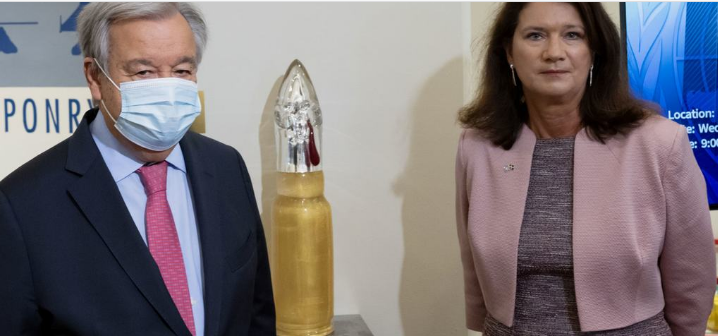The UN at its headquarters on Wednesday unveiled a new sculpture in honour and memory of two human rights experts murdered in the Democratic Republic of the Congo (DRC) five years ago.
Speaking at the unveiling of the sculpture in New York, UN Secretary-General António Guterres again expressed deep condolences to the families of Ms Zaida Catalán and Mr Michael Sharp.
Members of the families of the two human rights experts attended the dedication of the sculpture captioned ‘Abused Ammunition’, a glass carving which appears in the form of a golden bullet.
Catalán, who was from Sweden, and Sharp, an American, were members of the UN Group of Experts on the DRC, which supports the work of a Security Council Committee overseeing sanctions imposed on armed groups in the country.
“Zaida and Michael devoted their lives to advancing human rights and humanitarian action; and to supporting vulnerable people,” Guterres said.
They were abducted on March 12, 2017 while investigating reports of mass atrocities in the volatile Kasai region, following fighting between Congolese Government forces and armed militia.
UN peacekeepers found their bodies two weeks later outside the city of Kananga. The fate of their interpreter and three motorbike drivers remains unknown.
In January, a Congolese military court sentenced 51 people to death for their killing of the two experts.
“Their murder was a heinous crime.
“It was an assault on the values of the United Nations – an attack on the mission that countless women and men around the world risk their lives every day to uphold,” the UN chief said.
Abused Ammunition honours that mission, said the secretary-general, by imagining the sorrow of inanimate objects – in this case, bullets – over the part they play in death and destruction.
“The United Nations continues to assist the Congolese authorities in their investigation and prosecution of those responsible for killing Zaida and Michael, and the disappearance of the four Congolese citizens who were with them,” he said.
Guterres thanked the Swedish and U.S. governments who gifted the sculpture to the UN.
He also thanked Thommy Bremberg, the Swedish artist who produced the sculpture “for his message of empathy, and for honoring the achievements and sacrifices of United Nations personnel.”

















Discussion about this post